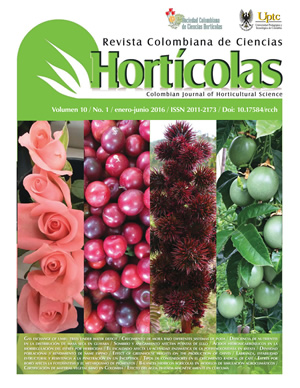Blanching treatment effect on the enzymatic activity of polyphenoloxidase in two varieties of sweet potato (Ipomoea batatas Lam.)
DOI:
https://doi.org/10.17584/rcch.2016v10i1.5125Keywords:
Enzyme inhibition, Camote, Bleached, PPO, Enzymatic browningAbstract
The effect of scalding time and temperature on the enzyme activity of polyphenol oxidase in two varieties of sweet potatoes (white and red) was studied with the aim of obtaining and evaluating the behavior of this enzyme. The samples were subjected to scalding temperatures (75, 80 and 85°C) and times of 30, 60, 90, 120, 150, 180 s in distilled water containing 0.5% citric acid and 1% ascorbic acid, regulating the pH and controlling the oxidation. In the evaluation of the temperature effect, the activity of the enzyme polyphenol oxidase in the red variety was initially ∆UAbs 0.263 min-1 mg-1 protein (variation of absorbance units per minute per gram of protein), which decreased to 0.0347 ∆UAbs min-1 mg-1 protein at the temperature of 85°C and 180 s. The white variety had a value of ∆UAbs 0.128 min-1 mg-1 protein, which decreased to values of ∆UAbs 0.0177 min-1 mg-1 protein at the same temperature and time. It was concluded that the activity of the enzyme polyphenol oxidase decreased by 86.8% in the red variety and 86.2% in the white variety through the blanching action.
JEL Classification
ArrayDownloads
References
Alvis, A., C. Vélez y M. Rada-Mendoza. 2008. Composición de ñames frescos cultivados en Colombia y sometidos a freído por inmersión. Información Tecnológica 19(1), 1-10.
Doi: 10.4067/S0718-07642008000100002
Amaya, E., R. Tarkus y M. Domínguez. 2008. Extracción y caracterización cinética de la enzima polifenoloxidasa del aguacate (Persea americana Miller) var. Hass. Revista de la Facultad de Ingeniería Química 47, 10-16.
Andrade, R. y J. Martins. 2002. Influência da adição da fécula de batata-doce (Ipomoea batatas Lam) sobre a viscosidade do permeado de soro de queijo. Cienc. Tecnol. Aliment. 22(3), 249-253. Doi: 10.1590/S0101-20612002000300009
Arrieta, W. y R. Gutiérrez R. 2009. Monografía del cultivo de la Batata (Ipomoea batatas Lam). Universidad de Córdoba, Montería, Colombia.
Brandelli, A. y C. López. 2005. Polyphenoloxidase activity, browning potential andphenolic content of peaches during postharvest ripening. J. Food Biochem. 29(16) 624-637. Doi: 10.1111/j.1745-4514.2005.00026.x
Casado, J., S. Selles y R. Bru. 2005. Purificación y caracterización cinética de la polifenoloxidasa (PPO) de frutos de tomate (Lycopersicon esculentum cv. Muchamiel). J. Food Biochem. 29(4), 381-401. Doi: 10.1111/j.1745-4514.2005.00037.x
Castro, J.A., L.E. Baquero y C.E. Narváez. 2006. Catalasa, peroxidasa y polifenoloxidasa de pitaya amarilla (Acanthocereus pitajaya). Rev. Colomb. Quim. 35(1) 91-101.
Cevallos, C. y Z. Cisneros. 2003. Estudios estequiométricos y cinéticos de antioxidantes fenólicos de Andina maíz morado y el camote de carne roja. J. Agr. Food Chem. 5, 3313-3319.
Cipriano, P., L. Ekici, R. Barnes, C. Gomes y S.Talcott. 2015. Pre-heating and polyphenol oxidase inhibition impact on extraction of purple sweet potato anthocyanins. Food Chem. 180, 227-234. Doi: 10.1016/j.foodchem.2015.02.020
Cob, N., J. Tello, J. Escamilla, L. Vargas y J. Tamayo. 2010. Actividad de la polifenoloxidasa en el gel de Sábila (Aloe vera Mill). Rev. Iber. Tecnol. Postcosecha 11(2), 221-227.
Cuevas, E., S. Hillebrand y P. Winterhalter. 2011. Anthocyanins in Purple Sweet Potato (Ipomoea batatas L.) varieties. Fruit Veg. Cereal Sci. Biotechnol. 5(special issue 2), 19-24.
Gao, L., L.C. Zhao, J.D. Duan y Y.L. Tao. 2014a. Study on the process of the reaction catalyzed by polyphenol oxidase from purple sweet potato. Adv. Mat. Res. 898, 153-156. Doi: 10.4028/www.scientific.net/AMR.898.153
Gao, L., Y. Yuan, Y.C. Li y Y.X. Wei. 2014b. Study on polyphenol oxidase activity in different parts of purple sweet potato. Adv. Mat. Res. 898, 149-152. Doi:
4028/www.scientific.net/AMR.898.149
Gao, L., L. Lin, L.C. Zhao y F. Wu. 2014c. Study on heat stability of polyphenol oxidase from purple sweet potato. Appl. Mechanics Mat. 716-717, 122-125. Doi: 10.4028/www.scientific.net/AMM.716-717.122
Gasull, E. y D. Becerra. 2010. Caracterización de polifenoloxidasa extraída de pera (cv. Packam’s Triumph) y manzana (cv. Red Delicious). Información Tecnológica 17(6), 69-74.
Gauillard, F. y F. Richard-Forget. 1997. Polyphenoloxidase from Williams pear (Pyrus communis L., cv. Williams): activation, purification and some properties. J. Food Sci. 74, 49-56. Doi: 10.1002/(SICI)1097-0010(199705)74:1<49::AID-JSFA769>3.0.CO;2-K
Guerrero, C. 2009. Inhibición de la actividad enzimática de la polifenoloxidasa extraída del banano (Cavendish valery) mediante sistemas bifásicos acuosos con isoespintanol y ácido ascórbico. Tesis de doctorado. Universidad Nacional de Colombia, Medellín, Colombia.
Guillou, N. 2012. Mecanismos y efectos asociados a procesos de oxidación de compuestos fenólicos en vinos. Trabajo de grado. Facultad de Ciencias Agronómicas, Universidad de Chile, Santiago.
Hee Kim, Y.,Sung Chul Park, Chang Yoon Ji, Jeung Joo Lee, Jae Cheol Jeong, Haeng-Soon Lee y Sang-Soo Kwak. 2015. Diverse antioxidant enzyme levels in different sweet potato root types during storage root formation. Plant Growth Regul. 75(1), 155-164. Doi: 10.1007/s10725-014-9940-x
Hernández, C. 2009. Acción y efectos de la polifenoloxidasa en alimentos. Universidad Veracruzana, Xalapa Enríquez, México.
Hernández, M., J. Torruco, L. Chel y D. Betancur. 2008. Caracterización fisicoquímica de almidones de tubérculos cultivados en Yucatán, México. Ciênc. Tecnol. Aliment. 28(3), 718-726. Doi: 10.1590/S0101-20612008000300031
IPC (International Potato Center). 2010. La batata en cifras: producción, utilización, consumo, alimentación. En: http://www.cipotato.org/sweetpotato/links.asp y http://.cipotato.org./sweetpotato/facts/batacif.pdf; consulta: abril de 2015.
Liu, P., A. Mujumdar, M. Zhang y H. Jiang. 2015. Comparison of three blanching treatments on the color and anthocyanin level of the microwave-assisted sprouted bed drying of purple flesh sweet potato. Drying Technol. 33, 66-71. Doi: 10.1080/07373937.2014.936558
Manohan, D. y W. Chen Wai. 2012. Characterization of polyphenol oxidase in sweet potato (Ipomoea batatas L.). J. Advancement Sci. Arts 3(1), 14-31.
Martí, H.R., H. D'Chudil y G. Corbino. 2011. La batata: El redescubrimiento de un cultivo. Ciencia Hoy 21(121), 17-23.
Mayorga, V. y B. Higuera. 2007. Aislamiento y caracterización de una polifenoloxidasa relacionada con la tolerancia del clavel (Dianthus caryophyllus) a Fusarium oxysporum sp. dianthi raza 2. Acta Biol. Colomb. 12(2), 81-94.
Mejía, C., D. Gaviria, R. Bru, L. Rengifo, Á. Alegría y E. Aguilar. 2014. Caracterización cinética de la enzima polifenoloxidasa en seis estadios de maduración en lulo (Solanum quitoense Lam.) var. Castilla. Actu. Biol. 36 (101), 107-117.
Mogollon, P., P. Lizarazo y Y. Quintero. 2010. Determinación de la actividad e inhibición de la polifenoloxidasa en el lulo (Solanum quitoense Lam.). @Limentech Cienc. Tecnol. Aliment. 8(2), 112-117.
Montenegro, L. 2015. Estudio de la Inhibición del pardeamiento enzimático por irradiación y de la calidad poscosecha durante el almacenamiento refrigerado de la naranjilla (Solanum quitoense Lam.) irradiada. Trabajo de grado. Facultad de Ingeniería Quimica y Agroindustrial, Escuela Politécnica Nacional, Quito.
Orozco, M., R. Prieto y L. Díaz. 2012. Efecto de la adición de cebolla, ajo y la aplicación de ultrasonido de alta intensidad sobre la actividad de la polifenoloxidasa en guacamole. Vitae 19(Supl. 1), S132-S134.
Pizzocaro, F., D. Torreggiani y G. Gilardi. 1993. Inhibition of apple polyphenoloxidase (PPO) by ascorbic acid, citric acid and sodium chloride. J. Food Proc. Pres. 17, 21-30. Doi: 10.1111/j.1745-4549.1993.tb00223.x
Rocha, A. y A. Morais. 2001. Characterization of polyphenoloxidase (PPO) extracted from ‘Jonagored’ apple. Food Control 12, 85-90. Doi: 10.1016/S0956-7135(00)00026-8
Samaniego, E., A. Ibarz y J. Ruales. 2014. Efecto de la irradiación ultravioleta en la actividad enzimática de la polifenoloxidasa y peroxidasa y las propiedades fisicoquímicas del jugo de dos variedades de Naranjilla (Solanum quitoense Lam.). Revista EPN 33(2).
Trujillo N., O. Urrutia y J. Pabón. 2011. Evaluación preliminar del efecto del pH y de la temperatura en la actividad de la polifenoloxidasa en papa amarilla (Solanum phureja), @limentech Cienc. Tecnol. Aliment. 9(2), 161-166
Truong, V. y R. Avula. 2010. Sweet potato purees and dehydrated powders for functional food ingredients. En: http://naldc.nal.usda.gov/naldc/download.xhtml?id=44182&content=PDF; consulta: junio de 2015.
Vargas, M., E. Sauri, E. Tamayo, S. González y J. Tamayo. 2015. Fresh-cut sapodilla (Achras sapota) with antioxidant activity; a modern demand for consumption fruits, Rev. Mex. Agronegocios 36, 1315-1324.
Yoruk, R y M.R. Marshall. 2003. Physicochemical properties and function of plant polyphenol oxidase: A review. J. Food Biochem. 27, 361-422. Doi: 10.1111/j.1745-4514.2003.tb00289.x
Downloads
Published
How to Cite
Issue
Section
License
The copyright of the articles and illustrations are the property of the Revista Colombiana de Ciencias Hortícolas. The editors authorize the use of the contents under the Creative Commons license Attribution-Noncommercial-ShareAlike 4.0 International (CC BY-NC-SA 4.0). The correct citation of the content must explicitly register the name of the journal, name (s) of the author (s), year, title of the article, volume, number, page of the article and DOI. Written permission is required from publishers to publish more than a short summary of the text or figures.


















